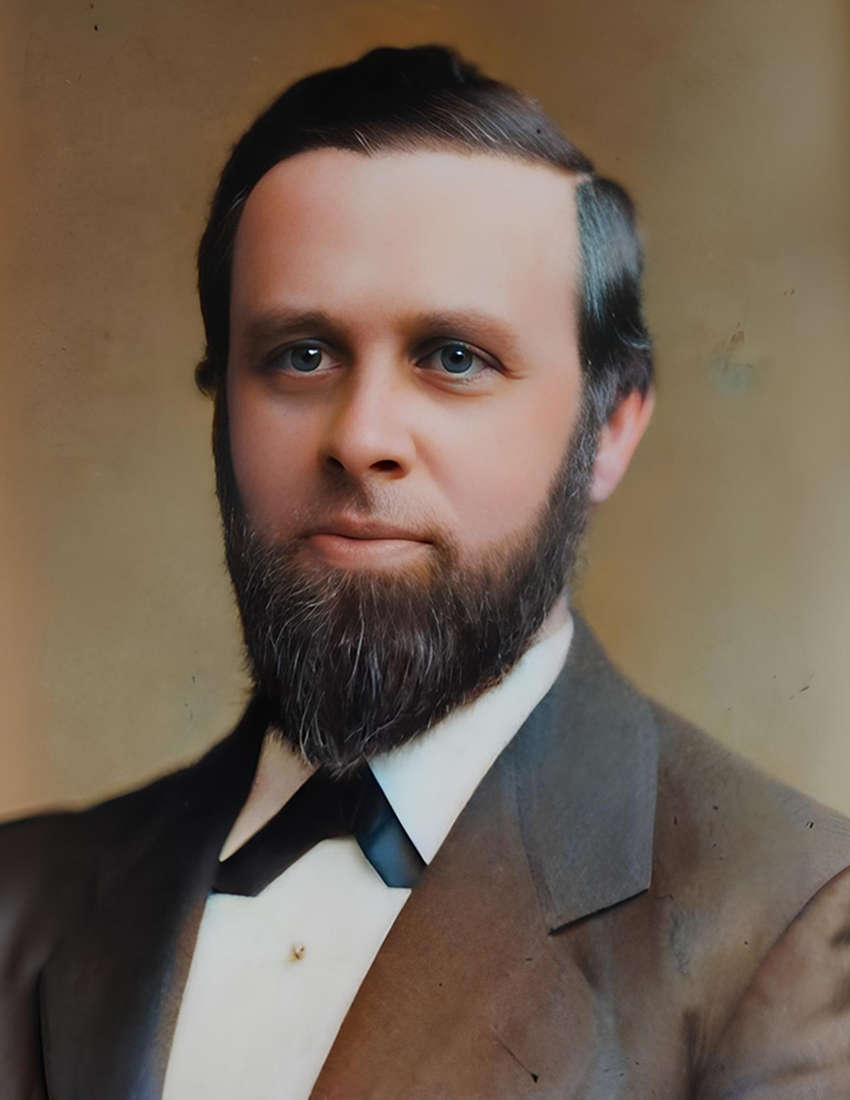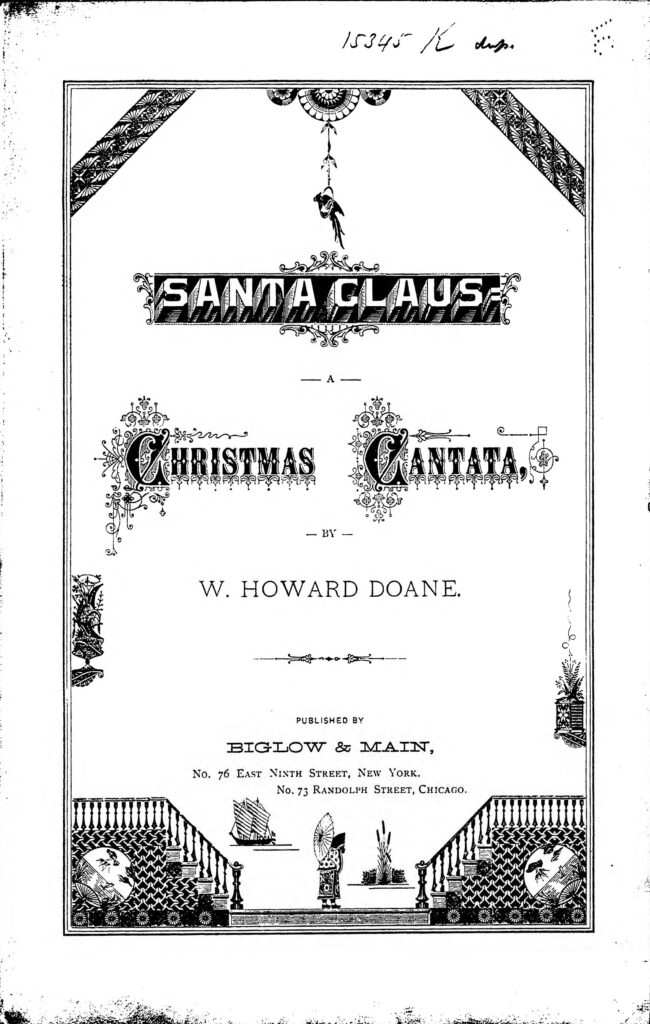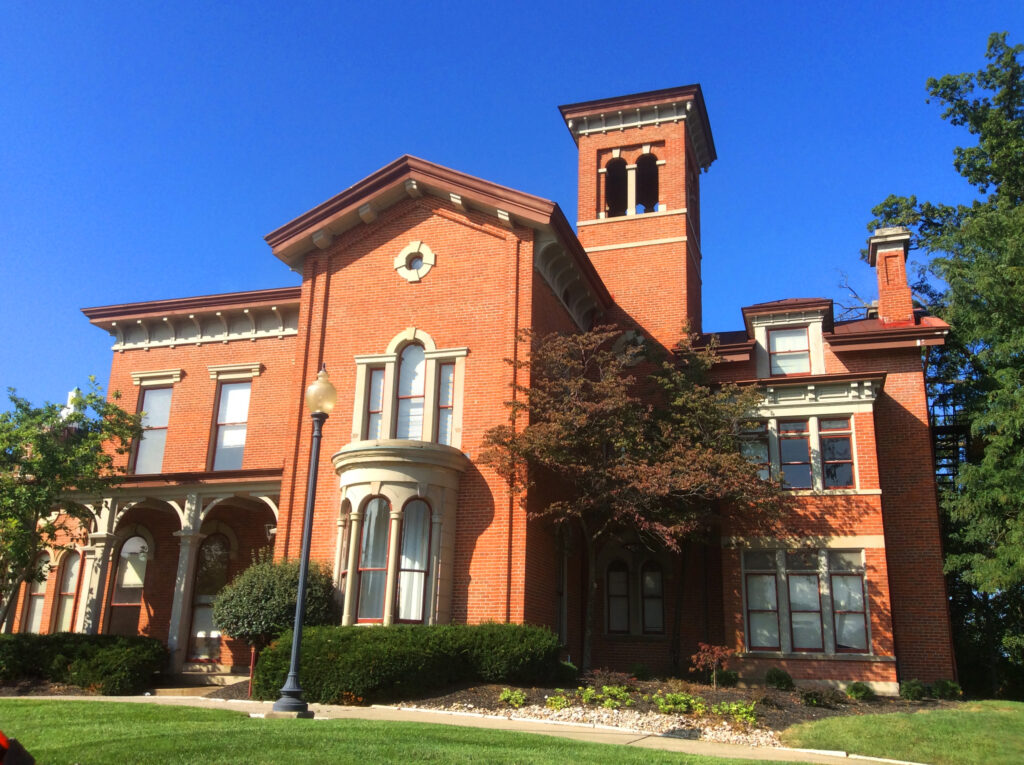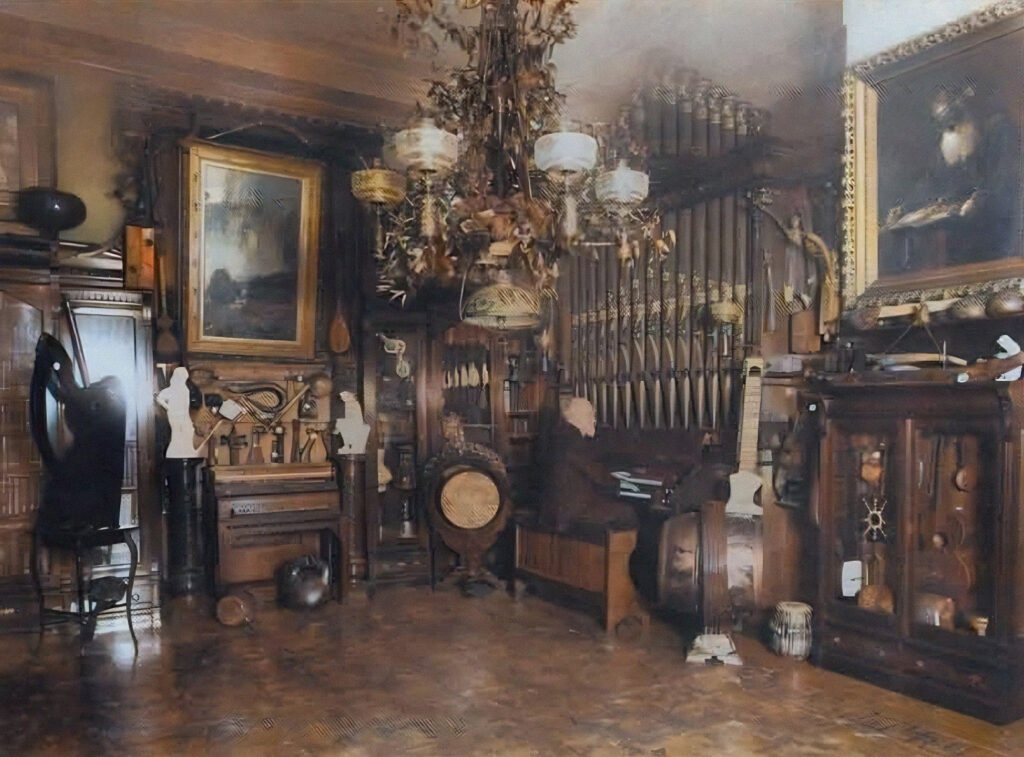Born: February 3, 1832, Preston, CT.
Died: December 23, 1915, South Orange, NJ.
Buried: Spring Grove Cemetery, Cincinnati, OH.
William Howard Doane

Cliff Barrows and Don Chapman discuss Crosby and Doane.
William Doane’s Delightful Christmas Cantata: “Santa Claus”
In 1879, Doane created a charming and accessible Christmas cantata entitled “Santa Claus.” This 48-page publication was designed to be performed by people of all ages and musical skill levels, including schools, Sunday Schools, and choirs. As the publishers, Biglow & Main, noted in their dedication, the cantata was conceived “to contribute to the enjoyment of the holiday season by furnishing a Musical Entertainment which might be given not only by the older people, but also by the Young Folks.”
The cantata, which can be performed with or without costumes, features simple solo and multi-part choral singing accompanied by piano or organ. It also includes non-musical recitations, making it accessible to a wide range of performers. The music is described as “bright and sparkling,” with a variety of musical elements such as solos, duets, choruses, songs by fairies, and even a visit from Santa Claus himself.
Doane’s “Santa Claus” cantata played a significant role in popularizing the Christmas cantata genre, and its circulation has been worldwide, with copies sold in the millions. This delightful and engaging work has become a beloved holiday tradition, bringing joy and merriment to countless performers and audiences alike.
Someone has recorded the entire Santa Claus Cantata – it’s a fascinating view into the music style of 1879 complete with old-timey piano and singing.
Little Willie’s Big Voice
At just six years old, little Willie Doane wasn’t content to sit on the sidelines of his first country Singing School. Too small to join the singers, he perched in the corner, soaking up every “Fa-Sol-La” like a musical sponge.
One evening, the Singing Master arrived at the Doane family home for an overnight stay. Violin in hand, he set about assessing the musical talents of the household, ready to “try their voices.” After testing the older children, Willie boldly piped up, “Try me!”
Expecting childish warbling, the Master was surprised by what he heard. “Why this little fellow has it perfect,” he exclaimed. Though Willie could barely read, he found himself placed with the alto singers. William Doane’s musical journey had begun!
The year was 1867. In a bustling New York City, two strangers’ paths crossed – an encounter that would alter the landscape of Christian hymnody forever. William Howard Doane, a successful businessman with a passion for music, had spent an entire day searching for the author of a hymn that had touched his soul. As evening fell, he finally found himself face-to-face with Fanny Crosby, the blind poetess whose words had stirred his heart. Little did they know, this moment would spark a collaboration that would produce over a thousand hymns, many of which continue to resonate in churches worldwide today. But who was William Howard Doane, this man whose melodies would become the soundtrack to countless worship services? His story is one of innovation, generosity, and an unwavering commitment to harmonizing faith with every aspect of life.
Early Life and Musical Beginnings
A man of remarkable talents and unwavering faith, William Howard Doane etched his name into the annals of history through a dizzying array of accomplishments: soul-stirring music, groundbreaking inventions, astute business acumen, and a generosity that knew no bounds. His life story unfolds like a symphony, each movement revealing a new facet of his multifaceted genius and deep-seated commitment to glorifying God and uplifting humanity.
Born on a crisp winter’s day – February 3, 1832, to be precise – in the quaint town of Preston, Connecticut, William Doane entered the world as the fifth of eight siblings. Joseph Howes Doane and Frances Treat Doane could scarcely have imagined the extraordinary path their son would blaze. From his earliest years, young William displayed an uncanny affinity for music. By the time he’d barely entered his teens, he had already mastered not one, not two, but three instruments: the flute, violin, and double bass fiddle. Talk about a prodigy!
His thirst for knowledge and leadership skills found fertile ground at Woodstock Academy, a prestigious private Congregational school. Here, amidst the hallowed halls of learning, Doane didn’t just excel – he soared. Taking the reins as choir director, he honed his musical prowess and leadership abilities, foreshadowing the harmonious blend of talents that would define his illustrious career.
A Successful Business Career and Innovative Inventor
Upon graduating from Woodstock Academy in 1848, Doane began his professional life in the accounting department of his father’s cotton manufacturing company. He later transitioned to J. A. Fay & Company, a woodworking machinery firm, where he rose through the ranks to become president by the age of thirty-four. During his tenure, Doane’s innovative spirit shone through, as he was credited with over seventy patents for advancements in woodworking machinery. His inventions significantly improved the quality of the company’s products, earning worldwide recognition, including the Grand Prix at the Paris Exposition of 1889.
A Prolific Hymn Writer and Collaborator
Despite his demanding business career, Doane’s true passion lay in music, particularly in the composition of hymns. He was a prolific writer, composing an estimated 2,300 works, including hundreds of original hymns and settings. Doane’s musical output extended beyond hymns, as he also composed secular instrumental, vocal, and choral pieces, including two cantatas based on the legend of Santa Claus. His Christmas cantatas played a significant role in popularizing the genre, bringing joy and inspiration to countless listeners during the holiday season.
A Heart-Stopping Revelation: Doane’s Musical Rebirth
William Doane’s journey to becoming a prolific composer of sacred music was not without its challenges. In fact, it took a serious health scare to redirect his musical aspirations.
Doane had initially resisted invitations to write Sunday School hymns, believing such work might diminish his reputation as a composer. He explains, “I had received invitations to write S. S. hymns for some of the churches, but invariably declined, feeling that it would detract rather than add to my reputation as a writer who longed for greater opportunities in oratorio compositions.”
However, a severe bout of heart disease forced Doane to reconsider his priorities. He consulted the best physicians in Chicago, who, upon learning of his roots in Plainfield, Connecticut, advised him to return home and rest on his porch, enjoying the fresh air. Despite following this advice, Doane, now with a wife and young daughter, found little improvement. He remained weak and troubled by fainting spells.
Desperate for a solution, his doctor recommended a return to Chicago to see if a “change of air” might help. It was during this train journey back, somewhere between Albany and Lockport, that Doane experienced a frightening episode of heart trouble. In this moment of crisis, he had what he believed to be a spiritual revelation. He recounts:
“As she (Doane’s wife Mary Frances) opened my curtains there seemed to be a flash of a thousand electric lights and all I could see was these words, ‘You refused.’”
This experience, combined with his wife’s reminder of her father’s warning about refusing to write music for “that good Chicago man,” led Doane to make a significant vow. He promised the Lord he would do anything He wanted, including writing sacred music.
Remarkably, Doane’s health began to improve shortly after making this commitment. He later reflected, “Within 24 hours I began to improve. My fainting spells left me, strength came and within a week I was able to continue the journey.”
True to his word, Doane dedicated himself to composing sacred music from that point forward. He maintained, “This vow I have sacredly kept and every dollar received from this source has been given back.”
This pivotal moment not only changed the course of Doane’s musical career but also deepened his commitment to using his talents for spiritual purposes. It set the stage for his prolific output of hymns and his fruitful collaboration with lyricists like Fanny Crosby.
The Fruitful Partnership of William Howard Doane and Fanny Crosby
One of the most significant collaborations in the history of Christian hymnody was that of William Doane and Fanny Crosby. Their partnership began in 1867 when Doane visited New York seeking a hymn for a special anniversary at the Five Points Mission. He was introduced to Crosby’s work and was so moved by her hymn “More Like Jesus” that he sought her out to collaborate further.
In her autobiography, “Memories of Eighty Years,” Crosby recounts their first meeting:
“In the year 1867 I met Dr. William H. Doane under very interesting circumstances. He had come from his home in Cincinnati to New York to visit his friend Dr. Van Meter of the Five Points Mission, and they were looking for a hymn that might be used on a certain anniversary. A number of standard hymns were given to Mr. Doane, but he did not find them appropriate. About this time I had been writing “More Like Jesus,” and Dr. Lowry asked me why I did not send it to Mr. Doane. I said, “Well, I will,” and accordingly sent it by a messenger boy.”
Doane was so impressed by Crosby’s work that he spent the entire day searching for her in the city. When he finally found her, he offered her twenty dollars for the hymn, saying, “The Lord had sent that hymn, and therefore meant that I should have the twenty dollars for it.” The following evening, Doane visited Crosby again and gave her the subject “Pass Me Not, O Gentle Savior.”
This marked the beginning of a fruitful partnership, with Doane composing the music for many of Crosby’s hymns. Together, they created approximately 1,000 hymn texts, including beloved classics such as “Rescue the Perishing,” “I Am Thine, O Lord,” “Near the Cross,” and “Safe in the Arms of Jesus.”
The story of “Pass Me Not, O Gentle Savior” is particularly noteworthy. Crosby wrote the hymn after Doane gave her the subject, and it became one of the first songs they wrote together. In her other autobiography, “Fanny Crosby’s Story of Ninety-Four Years,” Crosby stated that she wrote the hymn in 1868 using the subject supplied by Doane.
The Doane-Crosby alliance didn’t just leave a mark on Christian hymnody – it unleashed a tidal wave of musical devotion that continues to surge through sanctuaries worldwide. Their partnership? A veritable lightning rod of divine inspiration proving that when two distinct talents collide, the result can be nothing short of miraculous. Picture Crosby’s poetic insight, born of a sightless gaze but an all-seeing heart, melding with Doane’s melodic genius. The fruits of their creative communion – hymns that seem to breathe with a life of their own – have kindled faith and lifted spirits across generations.
A Devoted Church Leader and Choir Director
Raised in a Presbyterian household, Doane converted to his mother’s Baptist faith while attending Woodstock Academy. This conversion marked the beginning of a lifelong commitment to serving the church through his musical talents, leadership, and generosity. At Mt. Auburn Baptist Church in Cincinnati, Doane served as the superintendent of the Sunday school program and as the choir director for many years. His dedication to his faith also led him to assume leadership roles within the denomination, including heading the Ohio Baptist Convention Ministers Aid Society.
A Generous Philanthropist and Benefactor
Doane’s success in business and music allowed him to become a significant philanthropist, generously supporting Baptist churches, educational institutions, and various religious and civic organizations. One of his most notable contributions was to the Granville Academy, a preparatory school for boys planning to attend Denison University. In recognition of his substantial support, which included funding the construction of music, art, and gymnasium facilities, the academy was renamed Doane Academy in 1895.
Doane’s philanthropic legacy extended to numerous other institutions, including Denison University, Moody Bible Institute, and the YMCA. His generosity, along with that of his wife and daughters, continued to impact countless lives long after his passing.
A Lasting Legacy in Music and Beyond
William Howard Doane’s remarkable life came to a close on December 24, 1915, in South Orange, New Jersey. However, his legacy continues to reverberate through the enduring popularity of his hymns which are sung in churches worldwide, and through the institutions that bear his name, such as the Doane Administration Building and William Howard Doane Library at Denison University, and the Doane Memorial Music Building at Moody Bible Institute.
Doane’s impact extends beyond the realm of music, as his inventions in woodworking machinery contributed to significant advancements in the industry. His business acumen, coupled with his innovative spirit, helped to establish J. A. Fay & Company as a world leader in its field.
The life of William Howard Doane stands as an example of combining one’s talents, passions, and faith to create a lasting impact on the world. Through his music, inventions, business leadership and philanthropy, Doane orchestrated a life that transcended the ordinary, leaving an indelible mark on his community and the world at large. As we continue to sing his hymns and benefit from the institutions he supported, we are reminded of the legacy of a man who dedicated his life to serving Christ and enriching the lives of others through his many gifts.
Doane’s story isn’t just a biographical note in history’s margins. It’s a rousing anthem that challenges us to consider: How will we use our own unique gifts to create a melody that outlasts our earthly performance? In Doane’s life, we find not just inspiration, but an invitation – to compose our own lives with purpose, passion, and an eye towards eternity.
William Howard Doane’s impressive mansion, known as Sunnyside, is a historic home located at 2223 Mt. Auburn Avenue in Cincinnati, Ohio. Built around 1850 and purchased by Doane in 1879, the red brick residence features a unique entry flanked by two posts, one carved with “Sunny Side” and the other with Doane’s initials, “WHD.” Inside, Doane’s study housed a collection of rare instruments, while the music room boasted a magnificent pipe organ, with the first four measures of the Hallelujah Chorus frescoed above it. The first few measures of “Home Sweet Home” were also inscribed above the transom, a nod to Doane’s deep love for music. This impressive home served as a testament to Doane’s success as a businessman, hymn writer, and choral director.
A journalist wrote in 1933 that “Mr. Doane was an accomplished organist, and when playing for relaxation in the evenings there always would be hushed groups of neighbors gathered at the front fence.” In this colorized historic photo we see Doane seated at his 1879 E. & G.G.
Hook & Hastings pipe organ along with his collection of exotic instruments from his world travels.




